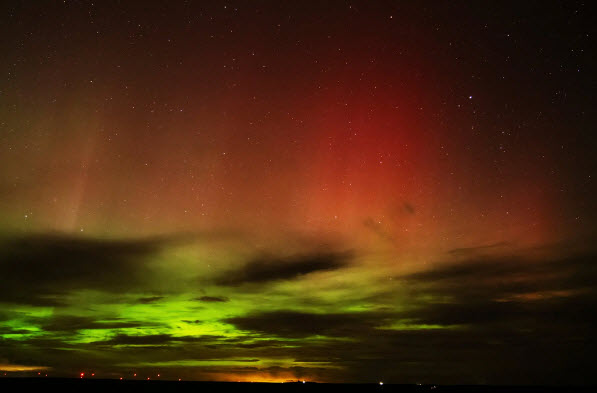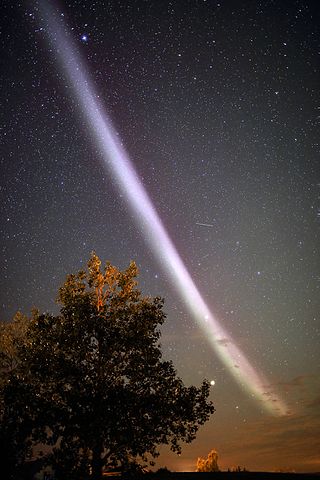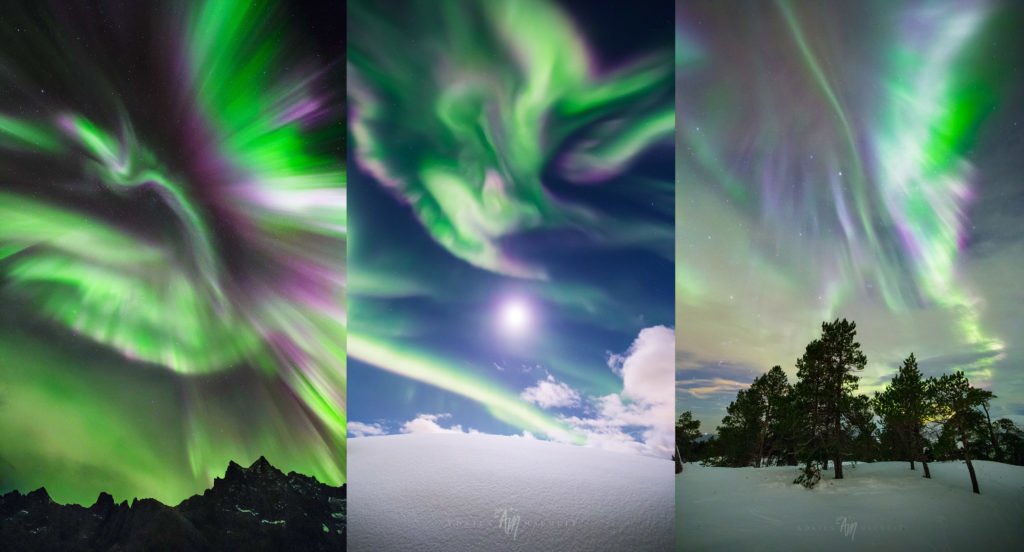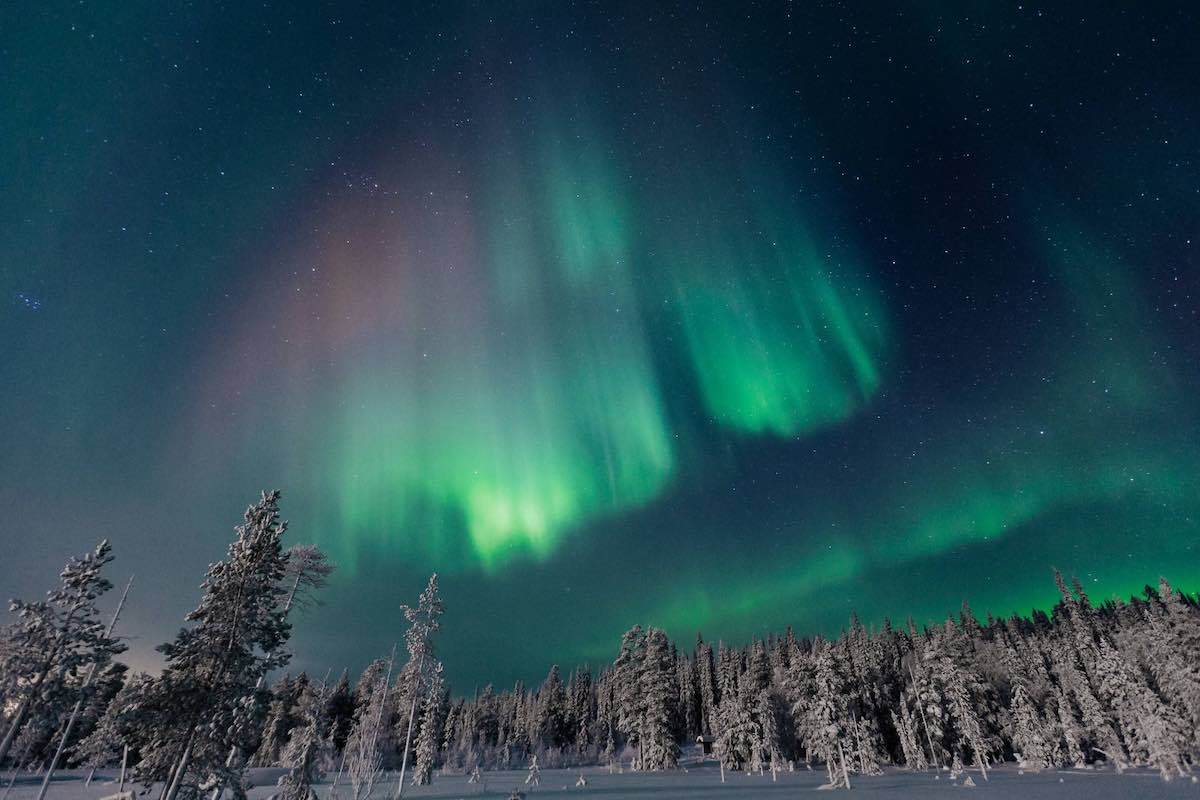On April 24, 2023, reports about an unusual weather event blew up social media. Specifically, people saw northern lights in places where this atmospheric phenomenon does not normally occur. The sky was painted purple, green, and yellow in Arizona, central California, and southern England. According to scientists, a geomagnetic storm caused this spectacular light show at those locations. But how do northern lights normally occur and what makes them so colorful? Let’s find out in this article.
 Image source: The New York Times, by Ted Warren/Associated Press
Image source: The New York Times, by Ted Warren/Associated Press
How Do the Northern Lights Form?
The northern lights, or aurora borealis, are natural light phenomena that typically occur near the North Pole. Auroras are caused by the sun, but not by its light. It is the solar wind that paints these multicolored lights into our atmosphere. Beyond the Arctic Circle, you can see the aurora borealis almost every day, also at the South Pole, where it is called aurora australis.
Aurora borealis glow forms when charged solar wind particles, captured by the planet’s magnetic field, interact with gases in the atmosphere. Therefore, it’s possible to see this phenomenon not only on the Earth but also, for example, on Jupiter. Here’s how it works:

- Our planet meets streams of charged particles from the sun.
- The magnetic field pulls the particles away, acting like a shield.
- The pressure from the sun “deflates” part of the magnetic field lines.
- In the area of the magnetic poles, charged particles from the sun penetrate under the protective layer of the planet.
- The charged particles begin to move around at a huge speed. This is how radiation forms in the Earth’s atmosphere.
- The charged particles react with gases in the atmosphere, producing excited and ionized gases. As a result, the glow appears.
On Jupiter, hydrogen atoms are excited by the same process but they glow in the ultraviolet range.
Each aurora borealis is unique. It has a different range of glow, shape, and duration. This is due to the uneven composition of the atmosphere and weather phenomena.
What Do Aurora Colors Depend On?
When the charged particles meet different elements, they create different colors of the aurora. The most common color of the northern lights is pale green. It results from the collision of electrons with oxygen atoms. The collision of these same particles can also produce a scarlet glow. At the same time, electrons bumping into nitrogen atoms result in violet auroras.
The intensity and frequency of the solar wind also play a role in the colors and patterns of the aurora borealis. Strong solar winds can create more intense and widespread displays with brighter and more vivid colors.
The table below summarizes the aurora colors and their characteristics:
| Aurora Color | Type of Gas | Height |
|---|---|---|
| Red | Oxygen at high altitudes | Higher than 150 miles or 241 km |
| Green | Oxygen at lower altitudes | Up to 150 miles or 241 km |
| Purple | Nitrogen | Higher than 60 miles or 96 km |
| Blue | Nitrogen | Up to 60 miles or 96 km |
Types of Northern Lights
The sky can glow in different ways and with different intensities. Depending on the cause of the polar lights, they are divided into the following categories:
- Electron. This type of northern lights occurs when charged electrons collide with particles in the air, resulting in all bright auroras that people admire.
- Proton. A poorly studied phenomenon. Most often protons collide with the air during magnetic storms. The glow may be invisible to the human eye but you can see it through the lens of a camera.
- STEVE. In 2015, a bright purple streak appeared in the Canadian sky. It occurred when a hot gas stream of about 5432°F (3,000°F) hit the air. Dr. Elizabeth McDonald, a space physicist at NASA, came up with a suitable name for this unique phenomenon - Strong Thermal Emission Velocity Enhancement. The original acronym for the phrase looks like STEVE.
 Image source: Elfiehall, CC BY-SA 4.0, via Wikimedia Commons
Image source: Elfiehall, CC BY-SA 4.0, via Wikimedia Commons
By form, auroral displays are classified into the following types:
- Arcs. Arcs are one of the most common types of aurora borealis and are characterized by bright, glowing bands that stretch across the sky. They are usually seen as a single arc or multiple arcs that intersect each other and can vary in size and shape.
- Bands. This is another common type of aurora borealis that is similar to arcs but appears wider and less structured.
- Rays. This is a type of polar light that looks like narrow beams radiating from a central point. They can last for several minutes or even hours, and their movements can be unpredictable. Some rays can appear to dance or flicker in the sky, adding to the beauty and magic of the northern lights.
- Diffuse. Diffuse auroras are fuzzy uniform spots in the sky. This kind of glow is calm, not bright. It can remain in the sky long enough, up to several hours, but it’s not always visible even at night. Sometimes only a camera with high light sensitivity can help.
- Discrete. This category of northern lights is a bright radiant structure that typically stretches along magnetic lines. Discrete auroras are short-lived - sometimes they exist no longer than a few seconds.
- Corona. The aurora corona, also known as a polar crown, appears as a bright circular or oval-shaped ring around the magnetic poles. This type of aurora is relatively rare and is characterized by its impressive size and unique shape. Other types of aurora, such as arcs or rays, can accompany the corona and intersect the ring.
 Image source: Aurora Live
Image source: Aurora Live
How Often Do the Northern Lights Occur?
Seeing an aurora in the sky in the north is not a sure thing for a traveler. In some regions, it appears up to 200 times a year, while in others only a couple of times. However, some factors can make it more likely for travelers to see a unique sight.
The occurrence of aurora borealis depends on geomagnetic and solar activity. The so-called magnetic storms increase the probability of seeing it. There are even specialized websites and apps that can show the aurora forecast. At the same time, strong disturbances can provoke auroras even at lower latitudes than usual, like it was in April 2023.
What Are the Best Places to See Northern Lights?
 Image source: Visit Finland, by Hannes Becker
Image source: Visit Finland, by Hannes Becker
The aurora borealis is typically seen in a wide irregular ring around the planet’s magnetic belt. It is located around 77-79 parallels and is about 19 degrees wide. Directly near the pole, you can observe auroras much less often, mainly during auroral substorms.
For new experiences of chasing the northern lights, better go to:
- Sweden, Iceland, Finland;
- England or Scotland;
- Canada, or Alaska.
Southern lights occur mainly in Antarctica and the Indian Sea. But they also appear at Cape Willson in Australia, in Tasmania, New Zealand, and in the south of Argentina.
Aurora Season: What Is the Best Time to Observe Polar Lights?
Sometimes you can wait for an aurora for several days or even weeks, depending on the region. But to increase the chances, you can focus on the cyclical nature of the processes:
- Daily. Most often, viewers observe auroras between 9 p.m. and 2 a.m. local time.
- Seasonal. Auroras appear more often between the spring (March 20) and autumn (September 22-23) equinox. Therefore, it is better to go for “aurora hunting” in spring or autumn.
- Solar. The sun has an 11-year peak of activity. In 2019-2020, the sun passed through a minimum of activity and entered a new phase. Its peak, and thus the brightest types of auroras, are predicted for summer and autumn 2025.
City lights and thick clouds can hide the polar lights from view. Therefore, it is better to observe them outdoors and only in clear weather.






